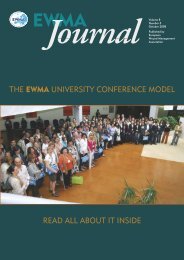Create successful ePaper yourself
Turn your PDF publications into a flip-book with our unique Google optimized e-Paper software.
Is it safe to use saline<br />
solution to clean wounds?<br />
INTRODUCTION<br />
The delivery of wound care has become increasingly<br />
technology based. However, some of the<br />
main problems related to impaired healing in<br />
wounds may be related to basic aspects such as<br />
cleansing, when it would be expected that, since<br />
enough evidence exists to indicate best practice<br />
in relation to the procedure (Blunt, 2001; Ellis,<br />
2004), healthcare professionals should have<br />
knowledge of this evidence.<br />
In primary health care in Portugal, wounds<br />
(chronic or acute) are usually cleansed with a sterile<br />
0.9 % (w/v) sodium chloride solution, usually<br />
termed physiological saline because it is isotonic<br />
for human cells (Flanagan, 1997) and innocuous<br />
and it is, therefore, generally the first choice solution<br />
for cleaning wounds (Davies, 1999). Isotonic<br />
sodium chloride solution is one of the best agents<br />
for cleaning open wounds because it removes debris<br />
and bacteria without cell destruction (Pina,<br />
1999, Cochrane, 2004). The major aim in wound<br />
cleaning is removal of organic and inorganic residues<br />
before application of the dressing thus maintaining<br />
an optimal environment at the wound site<br />
for healing (Morison et al., 1997). Other benefits<br />
of wound cleaning are: (i) to hydrate the wound<br />
surfaces and create a moist medium more favorable<br />
for healing; (ii) to preserve the surrounding<br />
skin, removing residues of glue and excess of<br />
humidity that can cause maceration, as well as<br />
erosion by action of enzymes of the exudates and<br />
toxic bacteria present on skin; (iii) to facilitate<br />
the visualization of the size and extension of the<br />
wound; (iv) to minimize the trauma of the wound<br />
due to the continuous use of adherent materials;<br />
(v) to reduce the risk of infection; and (vi) to<br />
promote the comfort of the ill person. (Morison<br />
et al., 1997; Agreda & Bou, 2004):<br />
The technique of wound cleansing has evolved<br />
through time. Thomlinson (1987) has demonstrated<br />
that the technique of rubbing the wounds<br />
<strong>EWMA</strong> Journal 2007 vol 7 no 2<br />
(with a swab held on a forceps) from the clean<br />
area to the dirty area, up and down and from the<br />
center to the border, only resulted in distribution<br />
of bacteria upon the surface of the wound. Additionally,<br />
the use of the swab and vigorous rubbing<br />
can cause trauma, especially in epithelial cells, as<br />
well as leave residues (little filaments of the swabs)<br />
that could delay healing by acting as foreign bodies<br />
that could remain in the deep tissues and serve<br />
as a focus of infection (Wood, 1976).<br />
In conclusion, the best choice for wound cleansing<br />
is the irrigation technique. Irrigation consists<br />
of gently removing residues on the surface of the<br />
wound as well as other contaminants (Lawrence,<br />
1997-1998). This is achieved by using fluids at<br />
constant pressure or pulsated pressure (Cooper<br />
et al., 2003).<br />
The optimal pressure for irrigation is achieved<br />
using a 35 ml syringe with a 19 G caliber needle.<br />
The disadvantages of this method are mainly:<br />
- the detachment of the needle during irrigation<br />
with the risk of causing injury to the<br />
patient and/or the professional;<br />
- the production of aerosols that could contaminate<br />
the environment or the professionals.<br />
At present, the professionals of the Health Subregion<br />
of Coimbra perform the cleaning of wounds<br />
by irrigation, using flasks of sodium chloride solution<br />
of 100 cc, 500 cc or 1000 cc, with a transfer<br />
attached. The same flask with transfer is used in<br />
several patients with resulting risk of contamination.<br />
OBJECTIVES<br />
The present study was undertaken with the objective<br />
of evaluating the level of microbial contamination<br />
of physiological saline flasks used in health<br />
centers for wound cleaning and identifying those<br />
microorganisms found.<br />
�<br />
Scientific Article<br />
João Carlos Gouveia<br />
Christina Miguens<br />
C. S. Pampilhosa Serra,<br />
P. Serra.,<br />
Portugal<br />
gouveia.miguens@sapo.pt

















